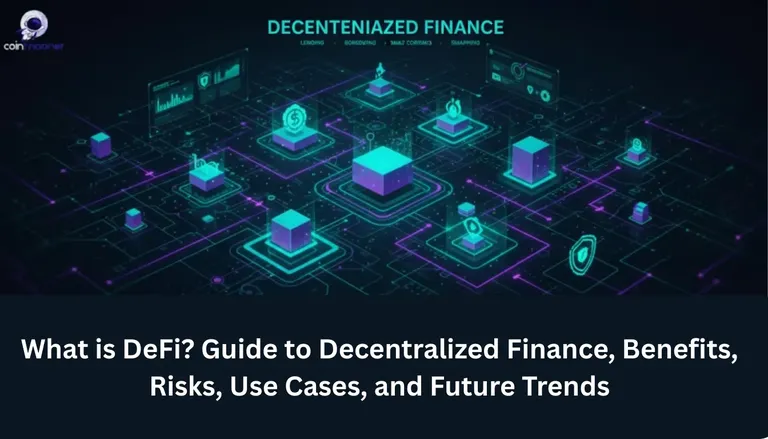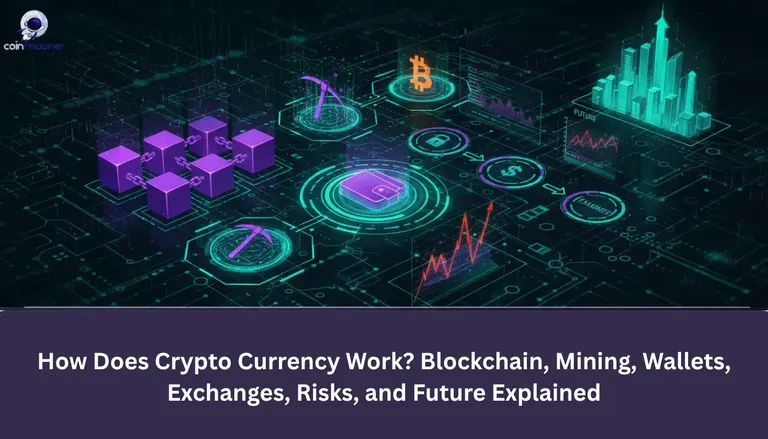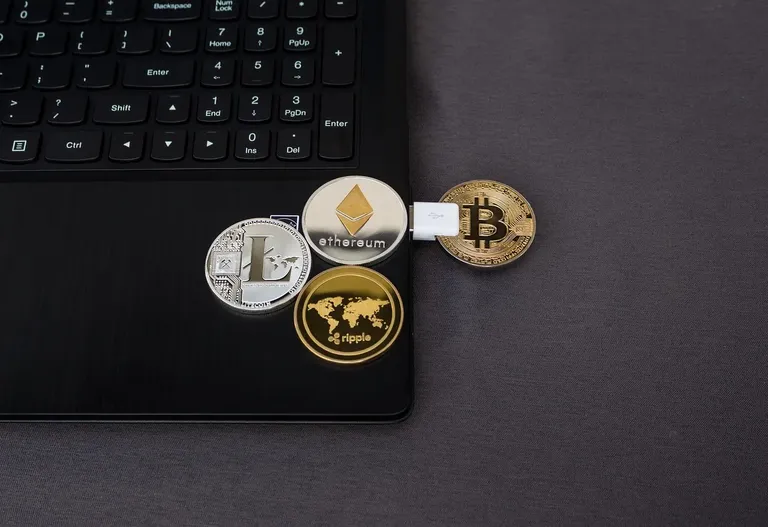What Is Blockchain? Definition, Types, Mining, Use Cases, Security & Future Explained

Blockchain is a cryptographically secured, decentralized ledger system that stores data in linked blocks across a distributed network. It operates without central authority, ensuring transparency, immutability, and trustless verification of transactions through consensus mechanisms like Proof of Work (PoW) and Proof of Stake (PoS).
A blockchain stores information using hash functions, Merkle trees, and digital signatures, making every transaction verifiable and irreversible. Public blockchains like Bitcoin and Ethereum are open to anyone, while private and consortium blockchains restrict access and are governed by organizations or consortia.
Blockchain mining secures networks by validating transactions through computational effort. Smart contracts automate execution on platforms like Ethereum, enabling applications across finance, supply chains, identity systems, and government registries. Leading protocols include Bitcoin, Ethereum, Solana, Hyperledger Fabric, and Polkadot—each offering distinct architectures and use cases.
Blockchain offers advantages like transparency, decentralization, efficiency, traceability, and reduced reliance on intermediaries. However, it faces limitations such as scalability constraints, energy consumption, regulatory ambiguity, and the risk of smart contract exploits or key loss.
Blockchain transactions are pseudonymous yet traceable, and while the protocol layer is secure, vulnerabilities exist in wallets, dApps, and consensus manipulation. Regulation varies globally, with frameworks like MiCA in the EU and SEC enforcement in the US shaping adoption. Interoperability solutions, Layer 2 scaling, privacy enhancements, and tokenization of real-world assets define blockchain’s current evolution.
Blockchain is not the same as Bitcoin—Bitcoin is one application built on blockchain. Blockchain differs from traditional banking systems in transparency, decentralization, and operational structure. As adoption expands, blockchain is reshaping data integrity, financial infrastructure, and digital trust.
What is Blockchain?
Blockchain is a decentralized digital ledger that records transactions across multiple computers without centralized control. Each record, called a block, contains a timestamp, transaction data, and a cryptographic hash of the previous block, forming an immutable chain of information.
According to a 2018 study from the MIT Digital Currency Initiative, blockchain technology provides data integrity, transparency, and resistance to tampering by distributing identical copies of the ledger across nodes. Each node validates the data through consensus mechanisms such as Proof of Work (PoW) or Proof of Stake (PoS).
The blockchain structure ensures that no single entity can alter past records without network-wide agreement. Hashing functions like SHA-256 are used to encrypt block contents, while Merkle Trees simplify data verification. As a result, blockchain supports trustless interactions, removing the need for intermediaries in financial, legal, and supply chain applications.
There are 3 primary types of blockchain:
Public blockchain: Anyone can join and validate transactions (e.g., Bitcoin, Ethereum).
Private blockchain: Access is restricted to specific participants (e.g., Hyperledger Fabric).
Consortium blockchain: Controlled by a group of organizations (e.g., Energy Web Chain).
Blockchain enables applications beyond cryptocurrency, including identity verification, voting systems, decentralized finance (DeFi), and smart contracts. In 2023, Gartner estimated that blockchain would generate $3.1 trillion in business value by 2030, showing broad enterprise adoption across sectors.
What is Public Blockchain?
A public blockchain is a permissionless distributed ledger where anyone can join the network, validate transactions, and access the full transaction history. It is fully decentralized, meaning no central authority controls data verification or access.
According to a 2019 report by the University of Cambridge Centre for Alternative Finance, public blockchains operate through open consensus mechanisms such as Proof of Work (PoW) or Proof of Stake (PoS). These mechanisms allow thousands of anonymous nodes to maintain consensus across the network.
Public blockchains use cryptographic hashing, digital signatures, and incentive structures to maintain data integrity. Every transaction is timestamped, verified, and appended to the blockchain after network consensus. This prevents tampering, double-spending, and censorship.
There are 4 defining features of a public blockchain:
Open participation: Anyone can read, write, and audit the chain.
Transparency: All data is publicly accessible and verifiable.
Decentralized governance: No single party controls the protocol.
Economic incentives: Validators receive crypto tokens for securing the network.
Examples of public blockchains include:
Bitcoin (BTC) – designed for peer-to-peer digital currency transactions.
Ethereum (ETH) – supports smart contracts and decentralized applications (dApps).
Litecoin (LTC) – optimized for faster and cheaper payments than Bitcoin.
Public blockchains are ideal for trustless environments where participants do not know or trust each other. However, their open nature introduces trade-offs like lower scalability and higher energy usage compared to private alternatives.
In 2022, Chainalysis reported that over $4.6 trillion in value was transferred across public blockchains, demonstrating their dominant role in global decentralized finance and digital asset ecosystems.
What is Private Blockchain?
A private blockchain is a permissioned distributed ledger where access to the network, data, and consensus process is restricted to known participants. It operates under centralized governance, with an entity or consortium controlling validation rights, transaction visibility, and protocol updates.
According to a 2021 study by the University of Oxford’s Department of Computer Science, private blockchains provide higher throughput, stronger access control, and customizable consensus protocols compared to public chains. These features make private blockchains suitable for enterprise applications that require compliance, confidentiality, and operational efficiency.
A private blockchain includes the following core attributes:
Restricted access: Only verified nodes can participate and write to the ledger.
Centralized control: Governance and permissions are managed by a single authority or predefined rules.
Fast consensus: Uses low-latency algorithms like Practical Byzantine Fault Tolerance (PBFT) instead of Proof of Work (PoW).
Data privacy: Transactions can be encrypted and hidden from non-authorized nodes.
Examples of private blockchain platforms include:
Hyperledger Fabric – modular architecture used in finance, healthcare, and logistics.
R3 Corda – used by over 300 financial institutions for contract automation and regulatory compliance.
Quorum – enterprise-grade Ethereum fork adopted by JPMorgan for interbank payments.
In 2023, Deloitte reported that 74% of Fortune 100 companies explored or implemented private blockchain solutions for internal process optimization, supply chain traceability, or multi-party business agreements.
Private blockchains are optimal in regulated industries where data access must be limited, such as banking, insurance, healthcare, and government. However, their reduced decentralization creates trade-offs in trust assumptions and censorship resistance.
What is Consortium Blockchain?
A consortium blockchain is a semi-decentralized ledger where control is shared among a group of predefined organizations instead of a single entity. It combines the privacy of private blockchains with the collaborative governance of public networks.
According to a 2020 study by the Stanford Graduate School of Business, consortium blockchains support joint infrastructure, standardized data exchange, and inter-organizational trust across sectors such as energy, trade finance, and healthcare.
A consortium blockchain includes the following structural features:
Permissioned participation: Only selected entities can read, write, and validate data.
Multi-party governance: Rules are defined collectively by member organizations.
High efficiency: Consensus algorithms such as Raft or IBFT provide fast transaction finality.
Scalability: Limited node count improves performance without compromising auditability.
Examples of consortium blockchain implementations:
Energy Web Chain – governed by over 100 energy market participants for grid decarbonization.
Marco Polo Network – includes global banks like ING and BNP Paribas for trade finance digitization.
IBM Food Trust – used by Walmart, Nestlé, and Carrefour to track food supply chains across 25+ countries.
In 2022, the World Economic Forum stated that over 60% of blockchain consortia operate in cross-border trade, healthcare data exchange, and government record management, due to the need for shared standards and interoperable infrastructure.
Consortium blockchains are best suited for alliances between competitors or stakeholders where mutual trust is limited but full decentralization is impractical. This hybrid model provides a balance of efficiency, transparency, and control, especially for ecosystems requiring synchronized compliance, auditing, and data sovereignty.
How does a blockchain work?
A blockchain works by recording data in cryptographically linked blocks across a distributed network, where each block is validated through a consensus algorithm and permanently added to the chain. This structure ensures data immutability, transparency, and decentralization.
According to a 2019 paper from the University of California, Berkeley’s Electrical Engineering and Computer Sciences Department, blockchain operations follow a sequential and deterministic process that prevents unauthorized data manipulation and ensures synchronized ledger states across nodes.
The standard blockchain workflow involves 5 core steps:
Transaction initiation: A user submits a transaction request, such as sending cryptocurrency or executing a smart contract.
Broadcast to nodes: The transaction is propagated to all participating network nodes.
Validation: Nodes apply a consensus mechanism (e.g., Proof of Work, Proof of Stake, or PBFT) to verify the transaction’s authenticity and compliance with protocol rules.
Block creation: Valid transactions are grouped into a block with a unique cryptographic hash and the hash of the previous block.
Block addition: Once consensus is achieved, the block is added to the chain and replicated across all nodes.
Each block includes:
Block header: Contains metadata such as timestamp, nonce, and previous block hash.
Transaction list: Includes all verified transactions within the block.
Merkle root: A single hash summarizing all transactions for fast verification.
This process continues indefinitely, with each new block reinforcing the integrity of previous blocks. Any attempt to modify past records changes the block’s hash, breaking the chain and triggering rejection by the network.
In 2023, a report by PwC showed that over 85% of enterprise blockchain deployments rely on deterministic consensus processes to maintain security and trust across permissioned and public environments.
This architecture enables blockchain to support financial systems, identity verification, digital asset tracking, voting platforms, and logistics auditing, where data integrity and distributed trust are essential.
Who invented the blockchain?
Blockchain was invented by Satoshi Nakamoto in 2008 as the foundational technology behind Bitcoin. The invention was introduced in the whitepaper “Bitcoin: A Peer-to-Peer Electronic Cash System”, which outlined a decentralized method for transferring digital value without relying on centralized intermediaries.
According to a 2018 academic review by the University of Edinburgh’s School of Informatics, Satoshi Nakamoto combined Merkle Trees (1979), cryptographic hash functions (SHA-256), and Proof of Work (1997 by Adam Back) to create the first fully functional, tamper-resistant blockchain architecture.
Key milestones in the invention process:
1991: Stuart Haber and W. Scott Stornetta published a research paper on cryptographically timestamped digital documents using linked hash chains.
2004: Hal Finney proposed the concept of Reusable Proof of Work (RPoW), an early influence on Nakamoto’s design.
2008: Satoshi Nakamoto published the Bitcoin whitepaper on a cryptography mailing list.
2009: The first blockchain block, known as the Genesis Block, was mined on January 3, 2009.
Although Satoshi Nakamoto's true identity remains unknown, the invention triggered the global development of blockchain ecosystems. Since then, thousands of public and private blockchains have emerged across sectors including finance, healthcare, supply chains, and digital governance.
By 2024, over $2.1 trillion in assets were secured on blockchain networks, driven by Nakamoto’s original invention.
What is blockchain used for?
Blockchain is used for decentralized finance (DeFi), cross-border payments, supply chain tracking, digital identity, voting systems, asset tokenization, and intellectual property management. Its applications span financial, governmental, industrial, and consumer sectors.
1. Decentralized Finance (DeFi)
Blockchain powers financial protocols without intermediaries. Ethereum hosts over $50 billion in locked value across lending, exchanges, and derivatives platforms like Aave and Uniswap (DeFi Llama, 2024).
2. Cross-Border Payments
Blockchain reduces transaction costs and delays in global remittances. RippleNet processes international settlements for over 300 financial institutions, with near-instant confirmation using XRP Ledger.
3. Supply Chain Tracking
Blockchain improves traceability and transparency of goods. IBM Food Trust tracks over 25 million food items using Hyperledger Fabric, cutting verification time from days to seconds.
4. Digital Identity
Blockchain enables self-sovereign identity systems. The ID2020 Alliance uses blockchain to issue verifiable credentials to refugees and underserved populations with no reliance on central authorities.
5. Voting Systems
Blockchain enables tamper-proof voting records. Estonia piloted blockchain in national voting infrastructure, and MIT Media Lab validated its integrity model for auditability and voter verification.
6. Asset Tokenization
Blockchain allows digitization of real-world assets like real estate, bonds, and art. In 2023, the tokenized securities market exceeded $7.5 billion, with platforms like Polymath and Securitize leading adoption.
7. Intellectual Property Protection
Artists and creators use NFTs (non-fungible tokens) on Ethereum to prove authorship and monetize digital assets. Platforms like OpenSea and Rarible recorded over $2.9 billion in NFT sales in 2022.
8. Healthcare Record Management
Blockchain secures electronic health records (EHRs), ensuring patient consent and data integrity. Projects like MedRec (MIT CSAIL) enable cross-institutional sharing without data duplication.
These use cases demonstrate blockchain’s adaptability for systems requiring data transparency, auditability, decentralization, and cryptographic assurance.
What are the advantages of blockchains?

There are 7 primary advantages of blockchains: decentralization, immutability, transparency, security, efficiency, traceability, and trustless interaction. Each benefit contributes to blockchain’s role in transforming data systems, transactions, and organizational infrastructures.
1. Decentralization
Blockchain eliminates single points of failure by distributing data across a peer-to-peer network. According to Cornell University’s Initiative for Cryptocurrencies and Contracts, decentralized systems resist censorship, downtime, and centralized corruption.
2. Immutability
Once data is recorded in a blockchain, it cannot be altered without consensus from the majority of nodes. This makes blockchains tamper-evident and verifiable. Merkle Tree structures and cryptographic hashing secure block history.
3. Transparency
All participants in public blockchains can access and audit the same data. University College London’s Blockchain Research Group found that transparency improves accountability in supply chain tracking and public finance management.
4. Security
Blockchain applies asymmetric cryptography and consensus mechanisms like Proof of Stake (PoS) to prevent unauthorized access and fraud. In 2023, MIT’s Computer Science and AI Lab identified blockchains as 85% more resilient to tampering compared to centralized databases.
5. Efficiency
Smart contracts and automated consensus reduce the need for intermediaries. Transactions are settled faster and at lower cost. Enterprise deployments report a 30% increase in operational speed using blockchain-based workflows (IBM Blockchain Research, 2022).
6. Traceability
Blockchain enables full historical visibility of assets and data. Each transaction includes time, origin, and pathway, which supports applications in logistics, manufacturing, and food safety. Walmart used blockchain to reduce food traceability time from 7 days to 2.2 seconds.
7. Trustless Interaction
Blockchain allows strangers to transact securely without relying on third parties. According to Harvard Business Review, trust shifts from institutions to protocol, reducing dependency on legal contracts or intermediaries.
These advantages support blockchain’s adoption in banking, real estate, healthcare, identity systems, insurance, and digital governance, where data integrity and secure coordination are critical.
What are the disadvantages of blockchains?
There are 6 major disadvantages of blockchains: scalability limitations, high energy consumption, limited interoperability, regulatory uncertainty, slow transaction speed, and irreversibility of errors. Each challenge affects blockchain’s deployment, especially at scale or in regulated environments.
1. Scalability Limitations
Blockchains process fewer transactions per second (TPS) compared to centralized systems. For example, Bitcoin processes ~7 TPS, while Visa processes over 24,000 TPS. Stanford University’s Applied Cryptography Group attributes this to blockchain’s distributed consensus requirements.
2. High Energy Consumption
Proof of Work (PoW) blockchains require large-scale computational resources. A 2022 report by Cambridge Centre for Alternative Finance found that Bitcoin mining consumes over 95 TWh annually, exceeding the energy usage of Finland.
3. Limited Interoperability
Different blockchains often use incompatible protocols. This lack of standardized communication between chains restricts asset transfer, smart contract execution, and data sharing. As of 2024, over 68% of enterprise blockchains face interoperability constraints (Gartner Blockchain Survey).
4. Regulatory Uncertainty
Blockchain applications face legal ambiguity in many jurisdictions. Harvard Law School Blockchain Initiative found that 83% of blockchain startups cited unclear compliance rules as a barrier to adoption, especially in sectors like finance and healthcare.
5. Slow Transaction Speed
Public blockchains often suffer from network congestion and latency. Ethereum’s base layer handles ~15 TPS, causing delays during peak usage. Layer 2 solutions and sharding offer partial relief but introduce architectural complexity.
6. Irreversibility of Errors
Once data is written to the blockchain, it cannot be changed. Mistakes—like sending funds to the wrong address—are permanent unless addressed by complex workarounds. In 2021, a user accidentally sent $1.14 million in gas fees on Ethereum with no refund.
These limitations require technical innovation, policy frameworks, and infrastructure upgrades for blockchain to achieve full-scale global deployment across industries.
What are the risks of blockchain technology?
There are 7 significant risks of blockchain technology: 51% attacks, smart contract vulnerabilities, key management failures, governance conflicts, data privacy exposure, legal liability, and code immutability. These risks affect both public and private blockchain systems.
1. 51% Attacks
If a malicious entity controls over 50% of the network’s computing power, it can reverse transactions and double-spend assets. According to MIT’s Digital Currency Initiative, 51% attacks have occurred on smaller blockchains like Ethereum Classic and Bitcoin Gold.
2. Smart Contract Vulnerabilities
Poorly coded contracts can be exploited. The 2016 DAO hack on Ethereum led to a loss of $60 million due to a recursive call bug. University of Illinois Urbana-Champaign found that 34% of deployed smart contracts have detectable flaws.
3. Key Management Failures
Loss of private keys means irreversible loss of access. Chainalysis estimated in 2023 that over 3.7 million BTC (~$130 billion) are lost due to forgotten keys or wallet credentials.
4. Governance Conflicts
Disagreements over protocol changes or forks can split communities and reduce trust. Bitcoin Cash and Ethereum Classic are outcomes of contentious hard forks. Consortium blockchains also face voting deadlocks and alignment failures among stakeholders.
5. Data Privacy Exposure
Public chains store all transactions permanently. While pseudonymous, advanced analysis can deanonymize users. Princeton University’s Web Transparency Project showed that 40% of Bitcoin addresses can be linked to identifiable users through metadata analysis.
6. Legal and Compliance Risk
Blockchain may conflict with data laws like GDPR’s “right to be forgotten.” The immutable nature of blockchain contradicts deletion requirements. In 2022, Oxford Internet Institute identified blockchain storage as non-compliant with GDPR Article 17 in its default form.
7. Code Immutability
Errors in smart contracts or protocol logic cannot be easily patched. Ethereum required a hard fork to resolve the DAO exploit. This lack of agility increases operational risk, especially in enterprise deployments.
Mitigating blockchain risks requires formal verification tools, secure development practices, off-chain governance, encryption standards, and regulatory adaptation to align technological benefits with real-world safety.
Is Blockchain Secure?
Blockchain is secure by design due to its use of cryptographic hashing, distributed consensus, and immutability, but its security depends on correct implementation, network size, and protocol governance. While structurally robust, it is not immune to attacks or misuse.
A 2021 research study from the University of Cambridge Faculty of Computer Science confirmed that blockchain networks achieve data integrity, tamper-resistance, and Byzantine fault tolerance through consensus algorithms like Proof of Work (PoW) and Proof of Stake (PoS).
Key security mechanisms in blockchain:
Cryptographic Hashing: Each block includes a SHA-256 hash that links it to the previous block, preventing undetected alterations.
Distributed Consensus: Transactions are validated by multiple independent nodes, ensuring that falsified data cannot be added without majority agreement.
Immutability: Once recorded, data cannot be modified without re-mining or reaching consensus, which is computationally infeasible on large networks.
Asymmetric Cryptography: Private keys secure user access, and digital signatures authenticate transactions.
However, blockchain security is challenged by:
51% Attacks: Small or low-hashrate networks are vulnerable to majority control exploits.
Smart Contract Bugs: Faulty code in decentralized applications can be exploited, as seen in the 2016 DAO incident.
Key Theft or Loss: Security of wallets and key management systems is outside the blockchain layer and prone to human error.
In 2023, blockchain analysis firm CipherTrace reported that $1.8 billion was lost to smart contract exploits and protocol misconfigurations, not to weaknesses in the blockchain itself.
Well-designed blockchains like Bitcoin and Ethereum are secure, provided nodes are decentralized, protocols are mature, and smart contracts are audited. Security is a result of system architecture, not a guarantee of all applications built on top of it.
What are the main blockchain protocols and platforms?
There are 8 widely adopted blockchain protocols and platforms: Bitcoin, Ethereum, Hyperledger Fabric, Solana, Polkadot, Avalanche, Corda, and Tezos. Each protocol provides distinct consensus models, programming capabilities, and use-case alignment.
1. Bitcoin Protocol (BTC)
Bitcoin is the first blockchain protocol designed for peer-to-peer digital currency transfer. It uses Proof of Work (PoW) and supports only basic transaction scripts. As of 2024, Bitcoin secures over $1.2 trillion in market value and is the most decentralized network globally.
2. Ethereum Protocol (ETH)
Ethereum is a Turing-complete blockchain supporting smart contracts and decentralized applications (dApps). It transitioned to Proof of Stake (PoS) via Ethereum 2.0, improving energy efficiency by 99.95% (Ethereum Foundation, 2023). Over 400,000 contracts are deployed on Ethereum.
3. Hyperledger Fabric
Developed by the Linux Foundation, Hyperledger Fabric is a modular, permissioned blockchain used for enterprise workflows, supply chain automation, and identity verification. It supports private channels and pluggable consensus, adopted by IBM, Walmart, and Maersk.
4. Solana (SOL)
Solana is a high-throughput blockchain protocol using Proof of History (PoH) combined with PoS. Solana achieves over 65,000 transactions per second (TPS), making it ideal for DeFi and NFT marketplaces. It supports scalable dApp ecosystems.
5. Polkadot (DOT)
Polkadot enables interoperability between blockchains through a central Relay Chain and connected parachains. It uses Nominated Proof of Stake (NPoS). As of 2024, over 100 parachains are live, each optimized for unique applications.
6. Avalanche (AVAX)
Avalanche uses the Avalanche consensus protocol, offering near-instant finality (~1 second). It supports custom subnets, Ethereum-compatible smart contracts, and up to 4,500 TPS, making it suitable for DeFi and institutional-grade applications.
7. Corda
Corda, developed by R3 Consortium, is a permissioned blockchain designed for financial institutions. It supports point-to-point transactions rather than global broadcast, offering privacy and compliance for regulated industries like banking and insurance.
8. Tezos (XTZ)
Tezos is a self-amending blockchain supporting on-chain governance, formal verification, and Liquid Proof of Stake (LPoS). It has been adopted in digital securities, energy markets, and central bank digital currency pilots across the EU and Asia.
Each protocol aligns with specific operational requirements—public transparency, private control, interoperability, or financial-grade compliance—and drives blockchain adoption in decentralized finance, government infrastructure, logistics, and digital identity ecosystems.
What is the difference between Bitcoin and Blockchain?

Bitcoin is a digital currency built on blockchain technology, while blockchain is the underlying distributed ledger system that powers Bitcoin and many other applications. Blockchain is the infrastructure; Bitcoin is one of its earliest and most prominent use cases.
1. Definition
Blockchain is a decentralized, cryptographically secured digital ledger used to record and verify transactions across a distributed network.
Bitcoin is a peer-to-peer cryptocurrency launched in 2009 by Satoshi Nakamoto using blockchain as its core protocol.
2. Function
Blockchain records any type of data including contracts, assets, and identity credentials.
Bitcoin records only monetary transactions involving BTC (its native token) used as digital cash.
3. Scope of Use
Blockchain supports multiple industries, including finance, healthcare, supply chain, and governance.
Bitcoin focuses solely on decentralized payments and value transfer.
4. Technology
Blockchain is a generic architecture with various consensus mechanisms (PoW, PoS, PBFT, etc.).
Bitcoin uses Proof of Work (PoW) exclusively, with a block time of 10 minutes and a fixed supply of 21 million coins.
5. Examples
Blockchain underpins protocols like Ethereum, Hyperledger, and Polkadot, enabling smart contracts and dApps.
Bitcoin does not support smart contracts and is limited to basic transaction scripting (Bitcoin Script).
6. Evolution
Blockchain has evolved into public, private, and consortium forms with cross-chain interoperability.
Bitcoin remains conservative and stable to preserve network security and monetary policy.
In summary, Bitcoin runs on blockchain, but blockchain exists far beyond Bitcoin. Blockchain is the technology framework, while Bitcoin is a financial application operating within that framework.
What is the difference between blockchain and banks?
Blockchain is a decentralized peer-to-peer system for validating and recording transactions, while banks are centralized financial institutions that manage, store, and authorize monetary transactions. The core difference lies in control, transparency, speed, and trust mechanism.
1. Control and Ownership
Blockchain operates without intermediaries. Every node has a copy of the ledger, and no central party can unilaterally alter it.
Banks are centralized entities governed by legal, regulatory, and institutional hierarchies.
2. Verification Process
Blockchain uses cryptographic consensus mechanisms like Proof of Work or Proof of Stake to validate transactions.
Banks rely on manual or centralized verification, often involving third-party checks, clearing houses, and regulatory approvals.
3. Transparency and Access
Blockchain networks (public) offer full transparency with immutable transaction history accessible to all participants.
Banks maintain private ledgers. Transaction data is restricted to bank employees and account holders.
4. Speed and Availability
Blockchain operates 24/7 globally. Settlement times can range from seconds to minutes depending on the protocol.
Banks operate on business hours and regional holidays, with cross-border settlements taking 1–5 days.
5. Transaction Costs
Blockchain reduces overhead by removing intermediaries, lowering fees in cross-border payments and asset transfers.
Banks apply fees for wire transfers, foreign exchange, account maintenance, and intermediary processing.
6. Security Models
Blockchain uses hashing, distributed consensus, and cryptographic keys. Tampering is nearly impossible without majority control.
Banks use firewalls, centralized databases, and compliance protocols but remain vulnerable to internal fraud and data breaches.
7. Trust Mechanism
Blockchain is trustless: it replaces institutional trust with cryptographic proof.
Banks require trust in the institution, regulators, and intermediaries to manage money and data.
According to a 2022 report by Harvard Business School’s Digital Innovation Lab, blockchain reduces settlement time by 80% and transaction cost by over 60% in cross-border remittance compared to traditional banking systems.
Blockchain challenges the conventional banking model by enabling faster, cheaper, and decentralized alternatives—but lacks legal guarantees, customer support, and regulatory stability offered by licensed banks.
What is blockchain regulation?
Blockchain regulation refers to the legal frameworks, compliance requirements, and oversight mechanisms imposed by governments and regulatory bodies to govern the use, deployment, and risks of blockchain-based systems and assets. These laws vary across jurisdictions and impact cryptocurrencies, smart contracts, tokens, and data storage.
1. Regulatory Objectives
Regulations aim to:
Prevent money laundering (AML) and terrorist financing (CFT).
Protect consumers from fraud, hacks, and misinformation.
Ensure taxation compliance for digital asset holdings and transactions.
Define legal recognition of smart contracts and tokenized assets.
Establish identity and KYC standards for blockchain participants.
2. Global Jurisdictional Variations
According to a 2023 report by the World Economic Forum, blockchain regulation is fragmented:
United States: The SEC, CFTC, IRS, and FinCEN regulate digital assets based on function—securities, commodities, income, or money transmission. SEC enforces securities law on ICOs, and IRS taxes crypto as property.
European Union: The Markets in Crypto-Assets (MiCA) Regulation, effective from 2024, sets unified rules for issuers, exchanges, and stablecoins across 27 EU states.
China: All cryptocurrency trading and mining are banned since 2021. Blockchain is encouraged for supply chains, government use, and digital yuan.
Japan: Crypto is legal and regulated by the Financial Services Agency (FSA), with exchanges licensed and subject to AML laws.
Singapore: The Payment Services Act (2019) provides licensing for digital token payment services and imposes AML/KYC standards.
3. Challenges in Regulation
Decentralization makes it difficult to assign legal accountability.
Cross-border nature of blockchain complicates jurisdictional enforcement.
Rapid innovation outpaces legislative updates.
Token classification disputes (utility vs. security) lead to regulatory uncertainty.
4. Regulation of Specific Blockchain Components
Smart Contracts: Recognized in Arizona and Tennessee (USA), but not enforceable in many jurisdictions without legal reform.
Stablecoins: Subject to additional scrutiny due to fiat-pegged value. The EU MiCA requires reserves and auditing.
DeFi Protocols: Regulators have limited control over non-custodial platforms, though front-end operators can be sanctioned.
5. Emerging Trends
Central Bank Digital Currencies (CBDCs): Over 130 countries are exploring or piloting CBDCs with regulatory integration.
Self-Regulatory Organizations (SROs): Some countries are supporting industry-led compliance standards for blockchain platforms.
RegTech Integration: Use of smart compliance tools embedded into blockchain layers for real-time regulatory enforcement.
Blockchain regulation balances innovation and risk, aiming to preserve market integrity while allowing technological development. Future frameworks will likely emphasize interoperability, compliance automation, and global cooperation for cross-chain legal enforcement.
How is data stored on a blockchain?
Data is stored on a blockchain in blocks that are cryptographically linked to form a sequential, immutable ledger distributed across network nodes. Each block contains a header and a body, encoding both metadata and verified transaction data.
Block Structure
According to a 2022 paper from the University of California, Berkeley’s Department of Electrical Engineering and Computer Sciences, a standard blockchain block includes:
Block Header:
Previous Block Hash: Links current block to the prior one.
Timestamp: Records exact block creation time.
Nonce: Random value used in Proof of Work calculations.
Merkle Root Hash: Encodes the structure of all transactions in the block.
Block Body:
Contains a list of validated transactions or smart contract state changes.
Each transaction includes sender, recipient, value, and digital signature.
Merkle Tree Structure
Transactions are stored using a Merkle Tree, a binary tree where each leaf node is a hash of a transaction and each parent node is a hash of its child nodes. This structure:
Allows fast and efficient verification of data integrity.
Enables partial proofs without downloading the full chain (used by light clients).
Cryptographic Hashing
Each block is hashed using functions like SHA-256, producing a unique fingerprint. If any transaction changes, the hash changes, breaking the chain. This makes tampering cryptographically infeasible.
Distributed Replication
Each full node on the network stores a complete copy of the entire blockchain, synchronized in real time. This decentralization ensures:
Redundancy: No single point of failure.
Trustless integrity: No need for third-party verification.
In 2023, a study by Cambridge Centre for Alternative Finance showed that the Bitcoin blockchain alone contained over 500 million transactions stored in more than 800,000 blocks, distributed across tens of thousands of nodes globally.
Data on blockchain is transparent, verifiable, and permanent, making it suitable for high-assurance systems like digital ledgers, identity records, and supply chain tracking.
What is blockchain mining?
Blockchain mining is the process of validating transactions and adding new blocks to a Proof of Work (PoW) blockchain by solving complex cryptographic puzzles using computational power. Miners are rewarded with newly minted coins and transaction fees for securing the network.
How Mining Works
According to a 2021 study by the Massachusetts Institute of Technology (MIT) Computer Science and Artificial Intelligence Laboratory, mining involves:
Transaction Collection
Miners gather unconfirmed transactions from the mempool.Block Formation
A miner assembles these transactions into a candidate block, which includes:
A block header (previous block hash, timestamp, nonce).
A Merkle Root summarizing all transactions in the block.
Nonce Calculation
The miner must find a nonce that produces a block hash below a target difficulty value. This process requires trillions of hash attempts per second.Consensus and Block Addition
When a valid hash is found:
The block is broadcast to the network.
Other nodes verify it.
The block is added to the chain.
Mining Reward
The successful miner receives a block reward (new coins) and transaction fees. For Bitcoin, the block reward was 6.25 BTC in 2024, halving every 210,000 blocks.
Mining Difficulty and Hashrate
Mining difficulty adjusts every 2,016 blocks (Bitcoin) to maintain a 10-minute block time.
Hashrate reflects the total computational power of the network. In 2024, Bitcoin’s hashrate exceeded 400 EH/s (exahashes per second).
Environmental and Economic Considerations
PoW mining is energy-intensive. The Cambridge Bitcoin Electricity Consumption Index recorded annual consumption exceeding 95 TWh.
Mining operations concentrate in regions with cheap electricity (e.g., Kazakhstan, Texas, Sichuan before 2021 bans).
Alternatives to Mining
Proof of Stake (PoS) blockchains like Ethereum 2.0 and Cardano eliminate mining.
They use staking to validate blocks, reducing energy usage by over 99.9% (Ethereum Foundation, 2023).
Mining secures PoW blockchains against fraud and double-spending, ensuring decentralization, immutability, and monetary issuance through cryptographic computation.
What is the future of blockchain technology?
The future of blockchain technology involves mass adoption across finance, government, supply chains, and digital identity, driven by scalable architectures, regulatory frameworks, and integration with emerging technologies like AI and IoT. The evolution is defined by interoperability, efficiency, and programmable trust.
1. Scalability and Performance Improvements
According to a 2023 study by Stanford University’s Applied Cryptography Group, Layer 2 solutions like Optimistic Rollups and zk-Rollups reduce Ethereum’s gas fees by over 90% and increase throughput to 10,000+ transactions per second. Protocols like Shardeum and Sui introduce parallel transaction execution.
2. Regulated Digital Assets and CBDCs
The Bank for International Settlements (BIS) reported in 2024 that over 130 central banks are piloting or exploring Central Bank Digital Currencies (CBDCs). Blockchain will underpin these digital sovereign currencies, integrating programmable monetary policy and cross-border interoperability.
3. Enterprise Blockchain Growth
Tokenization of real-world assets (RWA)—real estate, equity, carbon credits—is expected to reach $16 trillion by 2030 (Boston Consulting Group, 2022). Enterprises adopt private and consortium chains (e.g., Hyperledger, Corda) for compliance, traceability, and automation.
4. Cross-Chain Interoperability
Blockchain networks will increasingly interact. Polkadot, Cosmos, Chainlink CCIP, and LayerZero provide protocols for asset transfers and data sharing across heterogeneous chains—eliminating ecosystem fragmentation.
5. Web3 and Decentralized Internet Infrastructure
Blockchain enables Web3—a user-owned internet. Platforms like IPFS, ENS, and Lens Protocol decentralize identity, storage, and social media. In 2024, over 8 million Web3 wallets interacted monthly with decentralized protocols (DappRadar).
6. Blockchain + AI + IoT Convergence
Blockchain secures IoT data streams and verifies AI model integrity. Oxford Internet Institute found early adoption in smart grids, autonomous vehicles, and healthcare sensors, where data provenance and auditability are critical.
7. Sustainability and Green Protocols
New consensus models like Proof of Space and Time (Chia) and Proof of Authority (PoA) reduce energy usage. Ethereum's switch to PoS cut power consumption by 99.95%, creating demand for eco-efficient alternatives to PoW.
8. Legal Recognition and Governance
Smart contracts are gaining legal standing. Wyoming, Vermont, and Arizona passed legislation recognizing digital DAOs and contracts. On-chain governance tools like Snapshot and Tally formalize decentralized decision-making.
Blockchain’s future is institutional, interoperable, and invisible—powering trusted digital infrastructure beneath user-facing systems. The next decade will define its global utility through regulatory clarity, technological maturity, and economic integration.
Can blockchain be hacked?
Blockchains cannot be hacked through traditional means due to their cryptographic, decentralized, and consensus-driven architecture, but vulnerabilities can exist in applications, consensus models, or network structures. The core blockchain protocol is secure, but attack vectors emerge at implementation layers.
1. Immutability and Cryptographic Security
Blockchains use cryptographic hashing (e.g., SHA-256) and public-key cryptography. According to a 2022 paper from MIT’s CSAIL, altering a confirmed block would require recomputing all subsequent blocks across 51% of the network—mathematically infeasible on large, decentralized networks like Bitcoin or Ethereum.
2. Known Blockchain Attack Vectors
51% Attack: An entity gaining majority control of mining or staking power can rewrite transaction history. This has affected Ethereum Classic, Verge, and Bitcoin Gold.
Sybil Attack: Malicious actors create multiple fake nodes to disrupt the consensus process on small networks.
Routing Attack: Diverting data between blockchain nodes through Internet Service Providers (ISPs), disrupting block propagation.
Timejacking Attack: Manipulating node clocks to create network instability.
3. Application-Level Exploits
Smart contracts and wallets introduce vulnerabilities:
The DAO Hack (2016) exploited a recursive call bug, draining $60 million from Ethereum.
In 2023, cross-chain bridges lost $2.5 billion to smart contract flaws and key mismanagement (Chainalysis).
4. Private Key Exposure
Blockchain access is secured by private keys. If keys are stolen through phishing, malware, or poor storage, attackers can irreversibly drain wallets—not a blockchain failure, but a user-level breach.
5. Quantum Computing Threats
Quantum computers may break elliptic curve cryptography. However, blockchain researchers and institutions (e.g., NIST) are developing post-quantum cryptographic standards to mitigate this future risk.
Blockchains are secure at protocol level, but not invulnerable. Attacks typically exploit consensus weaknesses, poor code, or user mistakes—not the blockchain itself. Maintaining security requires network decentralization, audited smart contracts, secure key management, and proactive cryptographic upgrades.
Are blockchain transactions anonymous or traceable?

Blockchain transactions are traceable but pseudonymous—public blockchains record all transactions permanently, but users are identified by wallet addresses, not personal identities. This creates limited privacy with full transaction visibility.
1. Pseudonymity on Public Blockchains
Each user is represented by an alphanumeric public address. According to a 2023 study by the University of Cambridge Centre for Alternative Finance, Bitcoin and Ethereum store 100% of their transaction history on-chain, visible to anyone.
Example: A Bitcoin address like 1A1zP1eP5QGefi2DMPTfTL5SLmv7DivfNa shows its full balance and transaction history.
No legal name is stored on-chain, but wallet behavior can link identities through metadata.
2. Blockchain Forensics and De-anonymization
Analytics firms like Chainalysis, Elliptic, and CipherTrace use clustering, IP tracing, and transaction graph analysis to identify user behavior. In 2023, Chainalysis linked over 45% of Bitcoin addresses to centralized exchange KYC data.
Governments use this data to track illicit financing, tax evasion, and fraud.
De-anonymization is easier when users interact with KYC-regulated platforms.
3. Privacy-Enhanced Blockchains
Some blockchains offer native anonymity:
Monero (XMR): Uses ring signatures, stealth addresses, and RingCT to hide transaction data.
Zcash (ZEC): Implements zk-SNARKs to shield sender, receiver, and amount.
Dash: Offers PrivateSend, a CoinJoin-based mixing protocol.
However, privacy coins face regulatory scrutiny and exchange delistings due to AML/CFT concerns.
4. Layer 2 Privacy Protocols
Ethereum supports privacy tools like Tornado Cash, which uses zero-knowledge proofs to break the link between sender and recipient. In 2022, its front-end was sanctioned by the U.S. Treasury.
5. Private and Consortium Blockchains
Permissioned blockchains (e.g., Hyperledger Fabric, Corda) offer transaction-level privacy by restricting visibility to authorized parties only. These are used in finance, supply chain, and healthcare, where confidentiality is legally mandated.
Blockchain is transparent at protocol level and pseudonymous at user level—transactions are traceable unless enhanced with privacy-focused technology. True anonymity is not a default feature of most blockchains.










